

Maker Education - About Maker Education. How to Design Your Own MakerSpaces. What are MakerSpaces?
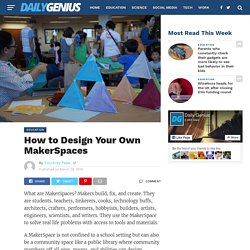
Makers build, fix, and create. Makers in the Classroom: A How To Guide. You see it everywhere in K-12.
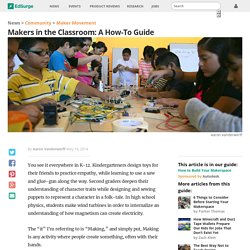
Kindergarteners design toys for their friends to practice empathy, while learning to use a saw and glue-gun along the way. Second graders deepen their understanding of character traits while designing and sewing puppets to represent a character in a folk-tale. In high school physics, students make wind turbines in order to internalize an understanding of how magnetism can create electricity. The “it” I’m referring to is “Making,” and simply put, Making is any activity where people create something, often with their hands. I often define Making by looking at what people bring to the Maker Faire, which does include more technical aspects like 3D printing, physical computing and programming. How Turning Math Into a Maker Workshop Can Bring Calculations to Life. Useful Apps and Resources to Help Students Learn Coding. April 29, 2017 Coding is an essential skill for 21st century students. 'When kids learn to code' , Mitch Resnick states, ' it enables them to learn many other things, opens up many new opportunities for learning.
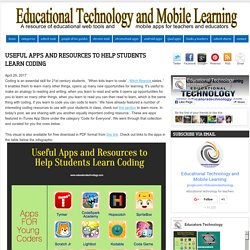
It's useful to make an analogy to reading and writing, when you learn to read and write it opens up opportunities for you to learn so many other things, when you learn to read you can then read to learn, which is the same thing with coding, if you learn to code you can code to learn.' We have already featured a number of interesting coding resources to use with your students in class, check out this section to learn more. In today's post, we are sharing with you another equally important coding resource . These are apps featured in iTunes App Store under the category 'Code for Everyone'. This visual is also available for free download in PDF format from this link. Upcycling and the Low-Tech Makerspace. You've read about the maker movement.
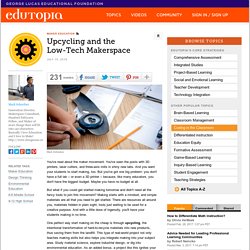
You've seen the posts with 3D printers, laser cutters, and three-axis mills in shiny new labs. And you want your students to start making, too. But you've got one big problem: you don't have a full lab -- or even a 3D printer -- because, like many educators, you don't have the biggest budget.
Maybe you have no budget at all. But what if you could get started making tomorrow and didn't need all the fancy tools to join this movement? One perfect way start making on the cheap is through upcycling, the intentional transformation of hard-to-recycle materials into new products, thus saving them from the landfill. Here's the five-step strategy that I've used to get my students making products out of hard-to-recycle materials. 1.
You can gather your own materials or, as I prefer, have your students source their own. Makerspace. Here, a Makerspace is a hybrid of a traditional lab's (e.g Wood/Metalshop, Science Lab, Computer Lab) function combined with new elements of making materials and technology tools as an interdisciplinary project-based learning space for a school.
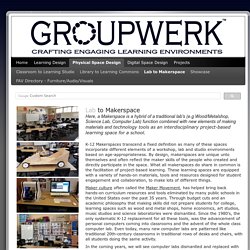
K-12 Makerspaces transcend a fixed definition as many of these spaces incorporate different elements of a workshop, lab and studio environments based on age-appropriateness. By design, makerspaces are unique unto themselves and often reflect the maker skills of the people who created and directly participate in the space. What all makerspaces do share in common is the facilitation of project-based learning. 10 Reasons to Create Makerspaces in Your School – The Tech Edvocate.
Makerspace is a relatively new method of teaching students in a space where they can get hands-on experience working with concepts they recently learned.
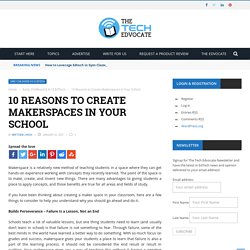
The point of the space is to make, create, and invent new things. There are many advantages to giving students a place to apply concepts, and those benefits are true for all areas and fields of study. If you have been thinking about creating a maker space in your classroom, here are a few things to consider to help you understand why you should go ahead and do it. Builds Perseverance – Failure Is a Lesson, Not an End Schools teach a lot of valuable lessons, but one thing students need to learn (and usually don’t learn in school) is that failure is not something to fear.
Schools say bye to shop class, hello to maker space. Delaware schools embrace building, testing...
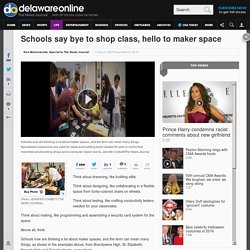
Schools now are thinking a lot about maker spaces, and the term can mean many things. Specialized classrooms are used for ideas and building tools needed for jobs in rooms that resemble woodworking shops and a computer repair rooms. Jennifer Corbett/The News Journal Think about dreaming, like building stilts. Think about designing, like collaborating in a flexible space from funky-colored chairs on wheels. Think about testing, like crafting conductivity testers needed for your classmates. Assessment in Making. After watching a room of students working and learning via a maker project, one can't help but be awed by the level of engagement.
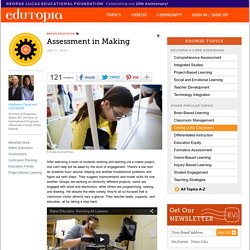
There's a low hum as students buzz around, helping one another troubleshoot problems and figure out next steps. They suggest improvements and model skills for one another. Groups are working on distinctly different projects; some are engaged with wood and electronics, while others are programming, sewing, and drawing. Yet despite the wide variety, they're all so focused that a classroom visitor attracts nary a glance. Their teacher leads, supports, and educates, all by taking a step back.
Maker education is being increasingly integrated into classrooms of all grade levels. Traditional direct instruction focuses on content knowledge, while maker-centered learning orients around the learner's context. Anyone who works with young makers sees this level of engagement, collaboration, and creativity. 1. We don’t know this definitively -- yet. 2. The Promises, Practices, and Pedagogies of Maker-Centered Learning: An Updated Preview of the Findings from the Agency by Design Project. August 17, 2016 When we launched the Agency by Design website early last year, we also released a white paper previewing the findings from our investigation of the promises, practices, and pedagogies of maker-centered learning.
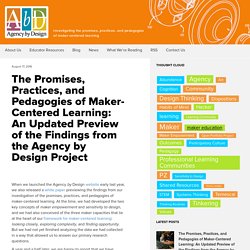
At the time, we had developed the two key concepts of maker empowerment and sensitivity to design, and we had also conceived of the three maker capacities that lie at the heart of our framework for maker-centered learning: looking closely, exploring complexity, and finding opportunity. But we had not yet finished analyzing the data we had collected in a way that allowed us to answer our primary research questions.
Makerspaces and Equal Access to Learning. Makerspaces are unique and attractive in today's schools.
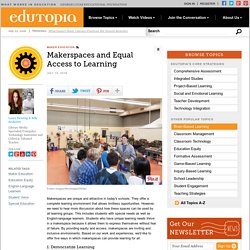
They offer a complete learning environment that allows limitless opportunities. However, we need to hear more discussion about how these spaces can be used by all learning groups. This includes students with special needs as well as English-language learners. Pinterest. A 24-Year-Old Designed A Self-Driving Minibus; Car Maker Local Motors Built It In Two Weeks : All Tech Considered. Edgar Sarmiento won the Local Motors challenge to design an urban public transportation system. His self-driving electric minibus design eventually became this vehicle called Olli. Alina Selyukh/NPR hide caption toggle caption Alina Selyukh/NPR Edgar Sarmiento won the Local Motors challenge to design an urban public transportation system. His self-driving electric minibus design eventually became this vehicle called Olli. Alina Selyukh/NPR At the recent unveiling of a new self-driving shuttle bus called Olli, its designer sat perched on a stool nearby, his hands cradling a camera in his lap.
Behind the Scenes of a Makerspace. Learning Spaces Behind the Scenes of a Makerspace The Rutgers University Makerspace has become a hub of creativity on campus. Here’s how it manages operations, equipment, projects and more. Four years ago, Rutgers University in New Jersey opened the Rutgers Makerspace — a place where students, faculty, staff and other members of the community can learn to use equipment such as 3D scanners and printers, laser cutters, cutting and milling machines, electronics, and power and hand tools, for both university-related and personal projects. Move, Shake, and Make: 3 Baby Steps to Bring Making to Your Classroom. You know you have “arrived” when the White House honors a week just for you. This June 17-23 President Obama and his staff will host the National Week of Makers. With the support of the President, it’s safe to say that making is not just a trend, rather it is a movement rapidly spreading across the educational landscape.
It has become commonplace to hear of urban makers quarters, events such as Maker Faires, and schools building maker spaces in community areas. Maker Education: Pedagogy, Andragogy, Heutagogy. Maker education is currently a major trend in education. But just saying that one is doing Maker Education really doesn’t define the teaching practices that an educator is using to facilitate it. Maker education takes on many forms. This post provides an overview of how maker education is being implemented based on the teaching practices as defined by the Pedagogy, Andragogy, Heutagogy (PAH) continuum. created by Jon Andrews Traditionally, Pedagogy was defined as the art of teaching children and Andragogy as teaching adults.
Create a school makerspace in 3 simple steps. Create, Collaborate, Innovate. What are great tools for a makerspace? What materials should I get? I get asked these questions a lot. I can’t answer that for you because I do not know the culture of your school. Makerspace for Education - Home. MAKING THE GRADE: HOW SCHOOLS ARE CREATING AND USING MAKERSPACES. About two years ago, Summit Elementary in Oconomowoc (WI) brought in laptops and ramped up its science and math curriculum in an effort to reach the hands-on, active learners who had already begun to check out. BBC brings coding to UK schools with 1 million micro:bit and 3D printable accessories. Mar 24, 2016 | By Alec When talking about the backgrounds of makers in Fablabs and similar locations, you usually hear the same story: that they became absolutely obsessed with building at a very young age. Can the Maker Movement Infiltrate Mainstream Classrooms?
At the White House Maker Faire recently, where President Obama invited “makers” of all ages to display their creations, the President investigated a robotic giraffe, a red weather balloon and shot a marshmallow cannon made by a student. With so much fanfare and media attention on the event, some educators are hopeful that the idea of tinkering as a way of learning might finally have made it back to the mainstream.
Untitled. Untitled. World-edu-online: Education: The Maker as a Reflective Practitioner. Walk into a classroom in any part of the United States, even the world, and you most likely will scratch your head in disbelief asking yourself questions such as: Top Web Resources to Motivate Kids for Maker Education. Untitled. Making is a Thinking Process! I continue learning with my students by applying designing thinking strategies and the thinking process of the 6 Cs . We keep on evolving with the process where the students become the specialists as they apply and reflect on their thinking progressions.
What’s in a MakerSpace? Middle School Maker Journey: Students' First Impressions of "Digital Shop" Education Week. 7 Arduino Kits For Young Programmers and Makers. Linking Literature to Makerspaces. 6 Fun Ways Kids Can Join the Maker Movement. Who is Maker Ed? The Mindset of the Maker Educator: Presentation Materials. How to Turn Your School Into a Maker Haven. MAKE STEAM: Giving Maker Education Some Context. School Libraries and Makerspaces: Can They Coexist? Untitled. 6 Fun Ways Kids Can Join the Maker Movement. School Libraries, Librarians and Education.
Reflecting on Making. 5 Truths about Making and Makerspaces in Our Libraries. Media-Making Toolkit : KQED Education. 6 Reasons Why Puppets Will Change Your Classroom Forever. ISTE 2015: Takeaway Tips for a Library Maker Space. 8 Design Steps for an Academic Makerspace. Gever Tulley: Life lessons through tinkering. Can the Maker Movement Infiltrate Mainstream Classrooms? Maker Faire Founder Dale Dougherty On The Past, Present, And Online Future Of The Maker Movement. What Exactly Is the Maker Movement? Maker faire ideas. Where the Magic Happens: library maker programs. 9 Goals of a Successful School Makerspace. Maker Monsters - Tell Friends and Build Creativity. 5 steps for creating a custom makerspace. Makers, Hackers & Educators: from them and for them! MakerBot Starter Labs. Lego Crosses The Digital Divide. From the Brainy minds of kids: NKY Makerspace. A Maker Space That Helps Kids Create During Long Hospital Stays.
Embracing Student Creativity With a Wonder Shelf. Makerspaces for Students With Special Needs. Why Kids Need to Tinker to Learn. The Maker Movement: Standing on the Shoulders of Giants to Own the Future. The Mindset of the Maker Educator. - A Tale of Two Libraries. MakerSpace: The Online Community for Makers. World Maker Faire, New York, Day 1. Nurturing the Innovator's Mindset in Your Classroom. How to Turn Your School Into a Maker Haven. RTy322_Maker Movement.pdf. Inexpensive making in the classroom. Why Your Library May Soon Have Laser Cutters and 3-D Printers.
LittleBits Education: The Workshop Set. To make is to learn: A Q&A with Dale Dougherty. How to Turn Your School Into a Maker Haven. - Maker Space In Education Series: 10 Sites To Start Making In The Classroom. The Maker movement makes its mark. Maker trailer - A documentary on the Maker Movement. The Changes Driving The Maker Movement. - Maker Space In Education Series: 10 Sites To Start Making In The Classroom. The Role of Peer Assessment in a Maker Classroom.
K12 educational transformation through technology. K12 educational transformation through technology.
Articles. Electronics. Projects & Resources.